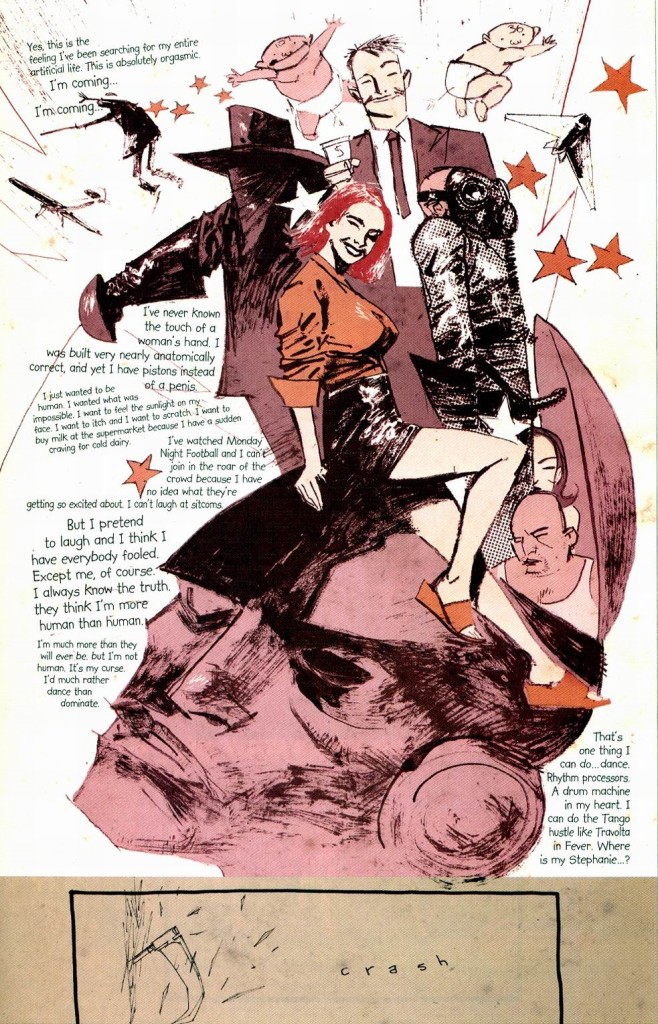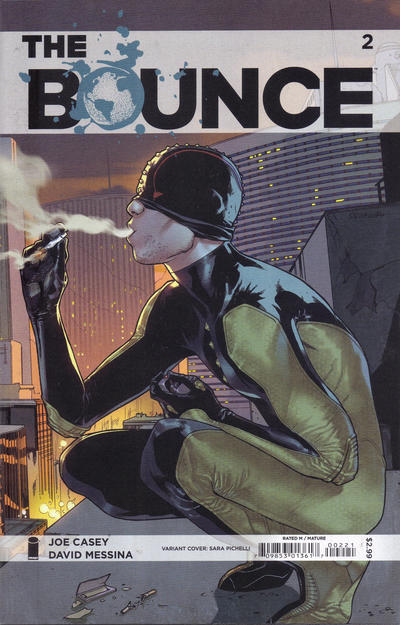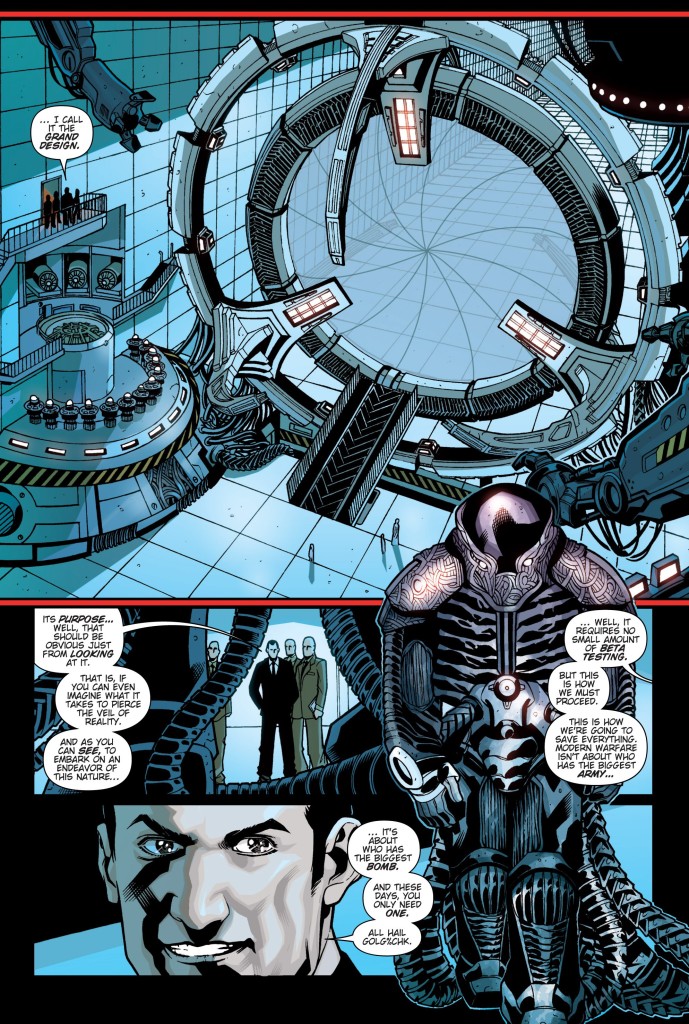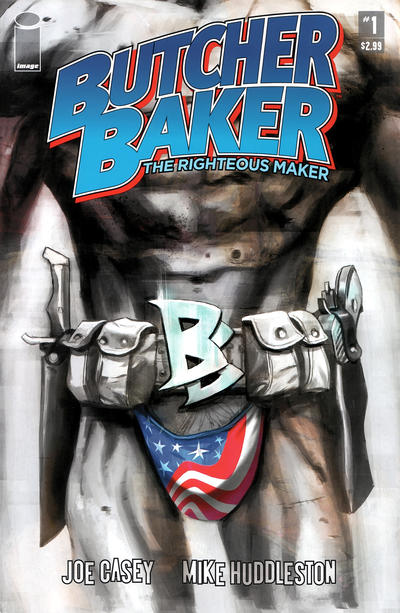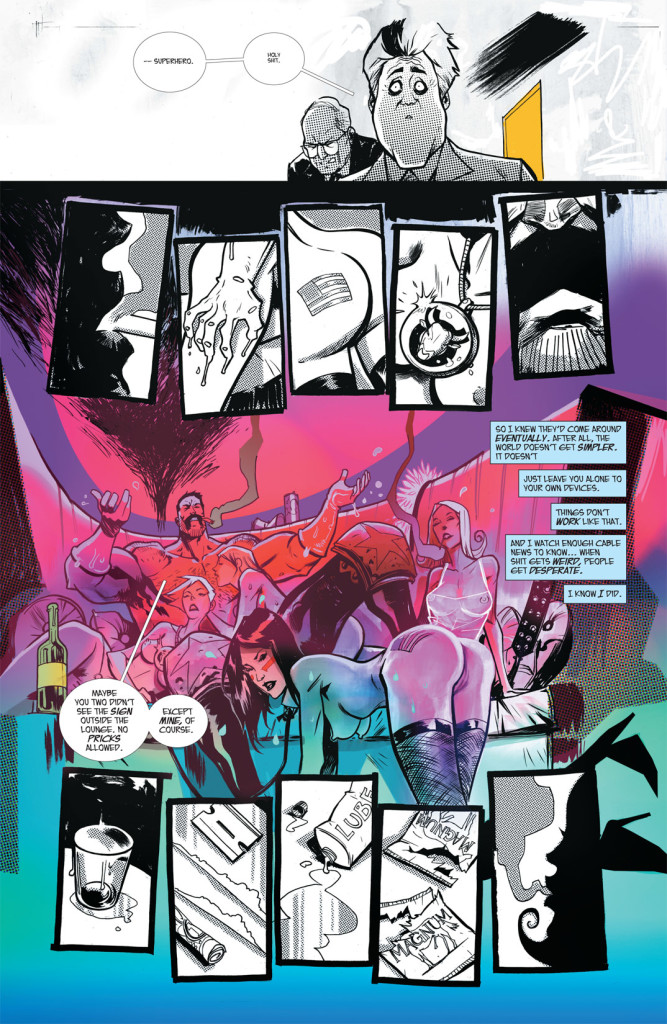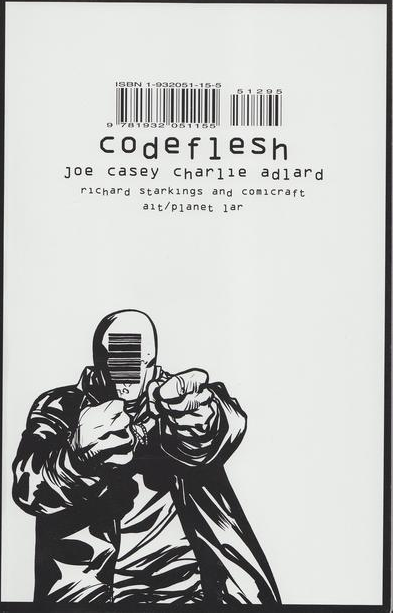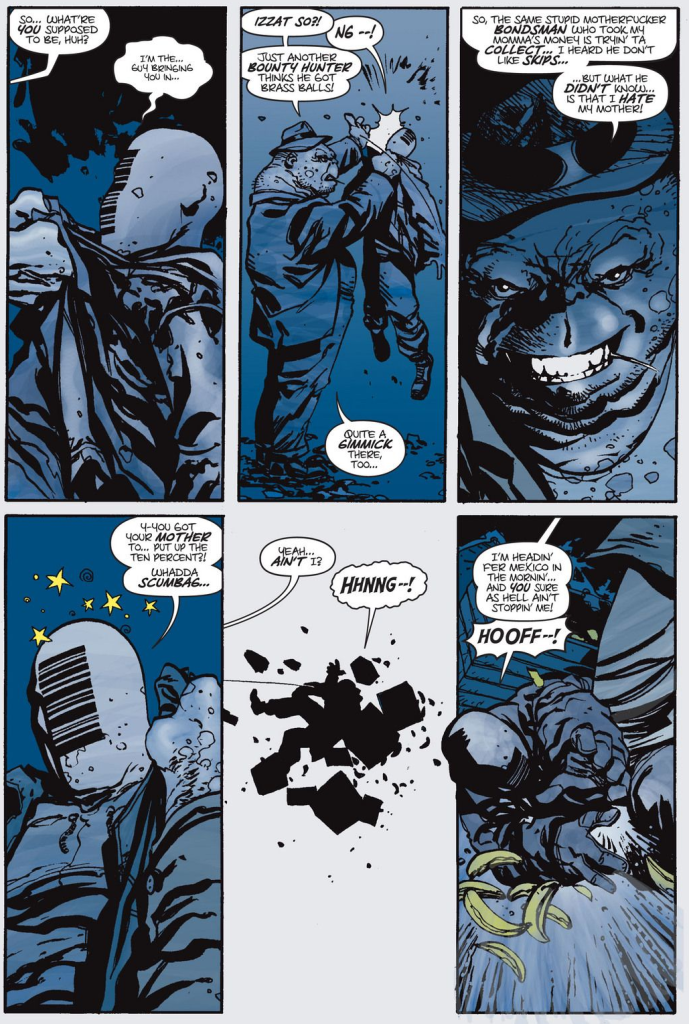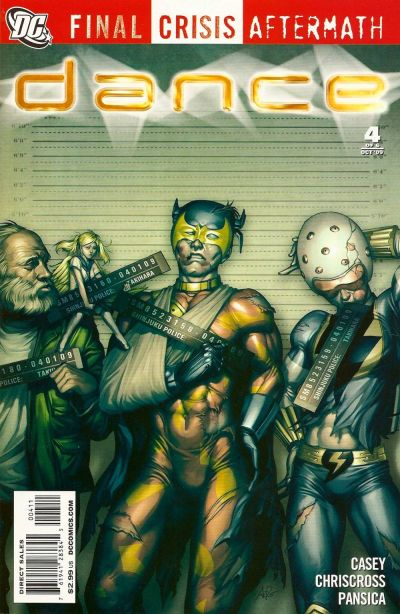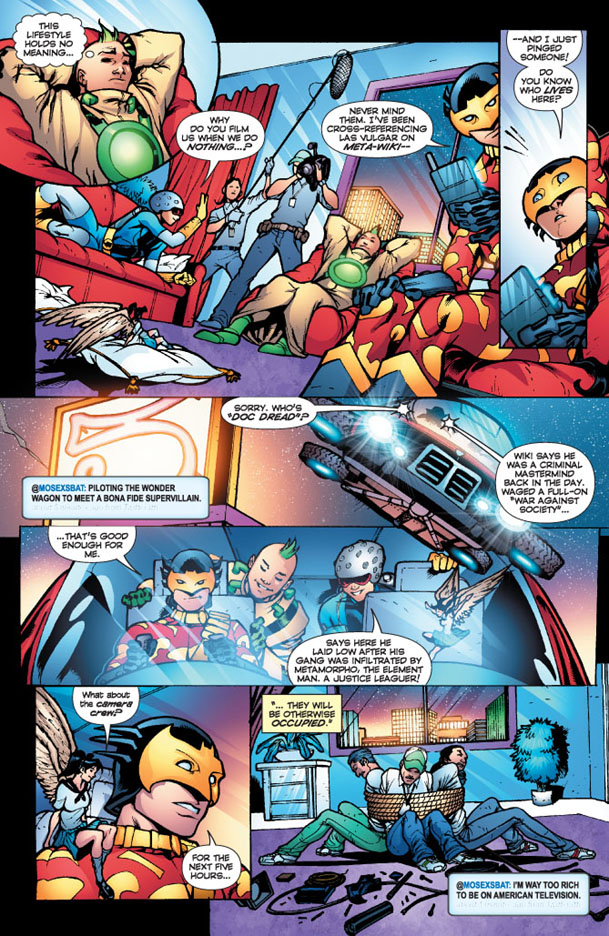In recent years, the Dark Knight has found himself in a number of surprising team-ups, crossing over with all sorts of odd properties, from Elmer Fudd to the Teenage Mutant Ninja Turtles. Since nothing appears to be out of bounds anymore, I for one would get a kick out of seeing the Bat-books cross over with some of the craziest series written by Joe Casey.
Joe Casey’s comics can be truly something special. They often have a clear metafictional edge, playing with traditional tropes, pushing the boundaries of the format, and/or drawing on the styles of other creators (especially Jack Kirby) in a self-reflexive way. Plus, they usually overflow with foul language, sex, drugs, and gory violence.
For all his transgressive attitude, you can feel Casey’s genuine enthusiasm and the desire to explore the medium’s potential. As he put it on the backmatter of Butcher Baker, the Righteous Maker, the ‘comicbook’ (one word) is ‘the perfect bullet delivery system for your entertainment-hungry lizard brain.’ Embracing the superhero genre in particular – both at its best (the bold zaniness and energy) and at its worst (typically narrow gender roles) – Casey tries to capture a childlike sense of unbridled imagination and exaggeration, even while filling the stories with R-rated content.
Although the main running motif of Casey’s work is rubbing in our faces how utterly cool comics can be, his books also tend to be sharp satires of celebrity culture and corporate power. The latter theme crops up, for example, in his Batman tales: the uneven two-parter ‘Tenses’ (in which Bruce Wayne restructures the business model of his company) and the neat Superman/Batman arc ‘Big Noise’ (in which we briefly see the contractor disputes to rebuild Metropolis and Gotham City after the ‘Our Worlds at War’ event). Neither of them is as bonkers as the greatest Casey comics, though, even if ‘Big Noise’ turns out to be particularly clever, using recognizable superhero story beats to address the War on Terror, with the Man of Steel and the Dark Knight embodying different perspectives in the end.
If Joe Casey was allowed to bring together his most outlandish creations and the world of the Caped Crusader, I’m sure the results would be epic. Here are some suggestions:
AUTOMATIC KAFKA
“I’m running a marathon, my friend. I’ve seen a lot of spectacle in my years on this earth… And I plan to see a lot more. The nature of our work demands that we conjure up the most fantastic, absurd solutions to the moral dilemmas that we’re lucky enough to wrestle with.” (The Warning)
One of Joe Casey’s earliest masterpieces, this 2002 series followed a depressed robotic superhero as he sought stimulation through dope and fame. Along the way, he bumped into washed-up villains from his heyday, in the eighties, as well as into the eccentric members of his former team, The $tranger$. The series – which lasted for nine mind-bending issues – was as meandering as its titular protagonist, but it kept throwing memorable ideas and visuals at us (like an evil scientist who had his own head replaced with a miniature spiral galaxy). The most bizarre tangent took place after Kafka reinvented himself as a sadistic game show host and we spent one whole issue focusing on the heartbreaking life of one contestant and his childhood friends (a grown-up Charlie Brown and the cast of Peanuts).
Published by WildStorm’s mature readers line Eye of the Storm, Automatic Kafka was an ‘adult’ superhero comic, not just in the sense of being full of tits and cursing (although there was plenty of that), but also in the sense of being an intellectually demanding, complex reading experience. In a way, the series could be seen as Casey’s homage to Grant Morrison, with riffs on Doom Patrol, a layered narrative carefully constructed like a mosaic with clues to a larger picture (thus rewarding multiple re-reads), and a metafictional conclusion that explicitly brought to mind Morrison’s work on Animal Man.
Just to make things even more experimental, the art was painted by Ashley Wood in a style that ranged from rough sketches to surrealist collages, as if ushering the reader to imagine a reality beyond the drawings, many of which seemed to be translating or suggesting the story rather than simply depicting it. Wood got a chance to shine from the get-go, as the comic kicked off with a trippy near-death hallucination after Kafka apparently overdosed on a drug designed specifically for androids, called ‘nanotecheroin’ (‘Finally, all your artificial intelligence systems can get their buzz on just like the fleshies do!’).
It’s not that farfetched to imagine Batman crossing paths with a character like Automatic Kafka, who already looks like the version of Robotman you’d find in Frank Miller’s Dark Knight universe. Since DC seems desperate to continue to milk Miller’s cash cow – including through sequels written or drawn by other creators – they might as well have the Goddamn Batman, in all his messed up excess, clash with The $tranger$, including The Constitution of the United States (an ultra-violent-patriot-turned-porn-star) and Helen of Troy (who is supernaturally sexy). Casey and Wood could finally resolve Automatic Kafka’s subplot about exploding babies, perhaps by tying it to the sentient dolls of DKR!
THE BOUNCE
“Gentlemen, we find ourselves standing at the crossroads of faith and fact.” (The Darling)
At first sight, this 12-issue series revolving around Jasper Jenkins, a stoner with the power to move around like a bouncing ball, may seem like one of Casey’s most conventional superhero sagas. The action is clear and exciting, the dialogue is peppered with amusing pop culture references, the hero is a likable, well-meaning loser with echoes of Spider-Man, and the main villain sounds like your average megalomaniac out to destroy the world (at one point, he looks at the White House and says that it’s like ‘driving past a museum piece’). David Messina’s art is effective without being particularly flashy – you could easily imagine his slick style in a mainstream book from the Big Two (he went on to draw Catwoman). Even the tonal shifts between escapist fare and edgier material aren’t that far removed from numerous other comics and, more recently, shows like Netflix’s The Defenders.
That said, the mysteries soon pile up, taking the narrative into unexpected places. Rest assured, The Bounce is not immune to Joe Casey’s flair for quirky concepts, whether it’s a dealer who is also the drug he’s dealing or ‘an entire sub-culture of secret quasi-religious corporations’ funding an inter-dimensional portal in order to weaponize a Lovecraftian entity.
Pre-Crisis Batman has fought – and was even killed by – a villain called The Bouncer, whose look and powers resembled the Bounce and who hasn’t been seen since 1981. In a possible crossover, perhaps the Caped Crusader would be searching for a rebooted version of that villain and bump into Jasper Jenkins instead. Since it has been established that Jenkins’ world possesses the technology to reach parallel dimensions, the crossover wouldn’t be much of a stretch!
Alternatively, given the metafictional dimension of the Bouncer’s debut story (‘The Strange Death of Batman!,’ Detective Comics #347), I can also picture Joe Casey writing a sort of remake that’d combine the two characters into one.
BUTCHER BAKER, THE RIGHTEOUS MAKER
“Here’s to the good ol’ days – the days where collateral damage was rebranded “acceptable losses” – the days of evil empires and femme fatales – the days of methodized mayhem – the days where middle management fuckheads like these two ate the peanuts out of my shit.” (Butcher Baker)
The depraved 2011 series Butcher Baker, the Righteous Maker followed a super-soldier secretly tasked by the government with killing villains held at a special state prison (the Bertrand Institute for Meta-Criminal Containment) in order to cynically cut costs. The result was a brash, cacophonous extravaganza consisting mostly of no-holds-barred chases and slugfests, as Baker fought a rogues’ gallery that included such cartoonish super-villains as the fat luchador El Sushi, the bearded mass murderer (and mash-up of orientalist stereotypes) Jihad Jones, and the shapely mysterious cosmic being known as The Absolutely.
Even though the series only lasted eight issues, Butcher Baker made quite an impression with his bushy mustache, his gung-ho attitude, and his star-spangled truck (called Liberty Belle). More than a spoof of Captain America, Baker was basically Watchmen’s Comedian on steroids – a hyper-macho psychopath who lived for fucking and slaughtering (he used to do it in the name of god and country, but ever since he saved the President of Reality at the Pan-Dimensional Affirmation Parade he stopped caring about that bullshit). You may wish to see the whole thing as a parody of US chauvinism, with the titular jock as the country’s unbound military id whose intended victims came back for vengeance, but the comic feels more invested in the entertainment value of watching these crude caricatures clash against each other rather than in making any meaningful statement about it.
Gorgeously illustrated by Mike Huddleston (who imbued the lively art with intoxicating colors), there wasn’t a single page on this series that wasn’t bombastic in some way. Hell, the first issue opened with Dick Cheney and Jay Leno walking in on Baker in the middle of an orgy and it barely lost momentum after that…
I guess the Batman series that most closely approached the manic, electrifying energy and gonzo villains of Butcher Baker, the Righteous Maker was The All-New Batman: The Brave and the Bold, which was coming out at the same time. Yet this is a tricky one… On the one hand, yes, the whole point of the latter comic was to see the Caped Crusader in goofy team-ups with other characters, no matter how strange. On the other hand, it’s hard to ignore the fact that Brave and the Bold sought to offer madcap romps that were suited for all ages, while the world and cast of Butcher Baker are very, very far from kid-friendly.
CODEFLESH
“A woman I know once told me that, even out of the joint, I had a doin’ time-kind of personality… a prisoner in my own mind. Maybe.” (Rotor)
There are many ways you can approach the concept of a bounty hunter specialized in super-villains who skip bail. In Codeflesh, Joe Casey did it as a relatively straight crime book, complete with a self-destructive anti-hero and a solid balance between dirty fights and touching character moments (it’s just that some of the criminals were telepaths or low-grade cyborgs). Charlie Adlard ran with this, giving the art a grounded, gritty look reminiscent of hardboiled ‘70s thrillers. Moreover, like The Bounce and Butcher Baker, the comic was elevated by the amazing letterer Rus Wooton, whose contribution always makes works feel groovier (he’s also a frequent collaborator of Jonathan Hickman, Rick Remender, and Robert Kirkman).
While overall the book is not as formally daring as some of the others on this list, the eighth chapter definitely stands out, as Casey, Adlard, and Wooton employ a highly original technique to convey how much the protagonist’s failing relationship is taking over his life. And even when they’re not reinventing the language of comics, the creative team delivers one moody, hard-hitting scene after another…
This crossover practically writes itself. Either Codeflesh’s masked bondsman follows a villain into Gotham City, teaming up with Batman in the process, or – better yet – he writes up the bond for someone like the Ratcatcher or the Mad Hatter, who jumps bail and runs out of town. Noirish hijinks ensue.
DANCE
“The world doesn’t need superheroes. We’re the ones who need a world to protect… otherwise, we’re just an outmoded concept that’s way past its sell date.” (Shiny Happy Aquazon)
The Japanese teen group Super Young Team was created by Grant Morrison and J.G. Jones for the massive DC event Final Crisis, in 2008, as a kind of 21st century version of Kirby’s The Forever People. The following year, Joe Casey and artists ChrisCross and Eduardo Pansica ran wild with the concept in the awesome mini-series Final Crisis Aftermath: Dance, in which an eager P.R. promoter led Super Young Team on an international tour in order to push their brand on a global scale… and to distract the masses (and the superheroes themselves) from what was going on in Japan at the time.
Sure, the series benefited from the groundwork laid by Jones and Morrison, who originally designed the heroes’ looks and personalities, including their over-the-top names: Most Excellent Superbat, Big Atomic Lantern Boy, Shiny Happy Aquazon, Crazy Shy Lolita Canary, and Well-Spoken Sonic Lightning Flash. But Dance not only expanded their corner of the world, it also tapped further into the millennial zeitgeist, indulging in Japanese pop culture and youth trends more generally – in a groundbreaking move at the time, the comic was peppered with Superbat’s snarky tweets (‘These clubbers don’t even have superpowers. Worthless.’), a device that still doesn’t feel dated a decade later. Much to the team’s occasional frustration, their adventures became as much about fads and marketing campaigns as about fighting monsters or saving the multiverse.
Even if you set aside the hip satire of media, consumerism, and corporate sponsorship, Dance still reads like a kickass superhero fantasy ride, including a delirious set piece where a cosplay competition in Dubai is attacked by an army of Nazi preppies called The Parasitic Teutons of Assimilation (almost all villains in Dance are against individual identity in some way). The whole series is just so damn smart and nifty-looking, not least because of Snakebite’s ultra-bright colors:
Since the members of Super Young Team live in the DCU, it’s easy to imagine them crossing paths with the Caped Crusader or one of his many sidekicks. Indeed, they had a couple of cameos in Batman Incorporated and there was even a fun special – written by Chris Burnham, with art by Jorge Lucas – about a date between Japan’s own Batman (Jiro Osamu) and Crazy Shy Lolita Canary.
But I want more. Let me see Grayson or Red Robin join the action during the Super Young Team’s inevitable, post-truth era rematch against the Brain Drain, the mind-controlling bacteria who infiltrated people’s consciousness through bottled oxygen (one of the team’s product endorsements), instilling a literal mob mentality!


